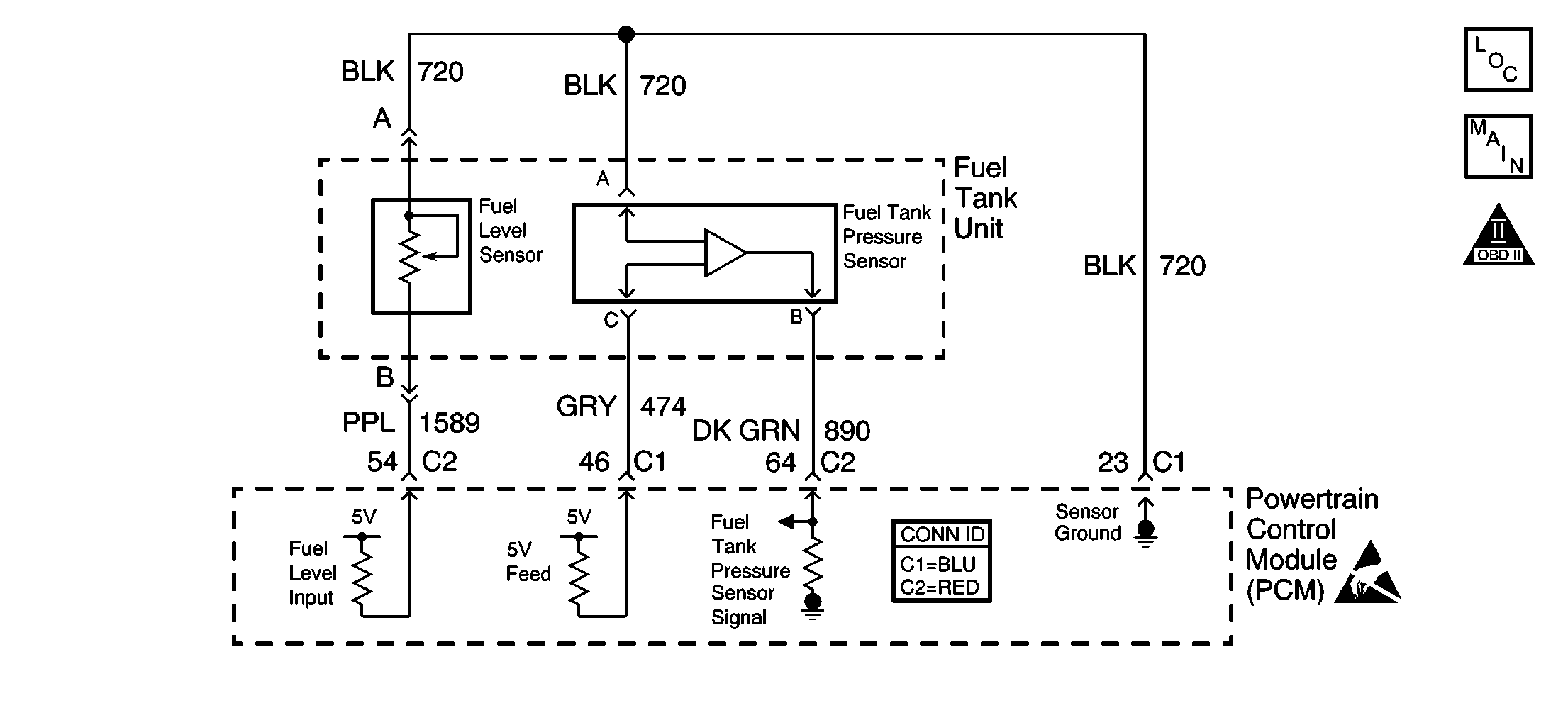
Circuit Description
The fuel level sensor changes resistance based on fuel level. The fuel level sensor has a signal circuit and a ground circuit. The powertrain control module (PCM) applies about 5.0 volts on the signal circuit to the sensor. The PCM monitors the changes in this voltage caused by changes in the resistance of the sensor in order to determine fuel level.
When the fuel tank is full, the sensor resistance is high, and the PCM signal voltage is only pulled down a small amount through the sensor to ground. Therefore, the PCM will sense a high signal voltage or full fuel tank. When the fuel tank is empty, the sensor resistance is low, and the signal voltage is pulled down a greater amount. This causes the PCM to sense a low signal voltage or empty fuel tank.
The PCM uses inputs from the fuel level sensor in order to calculate the total fuel remaining in the fuel tank. The PCM uses the fuel level information for the evaporative emission (EVAP) and misfire diagnostics. The fuel level information is sent to the instrument panel cluster (IPC) via the PCM. The instrument panel (IP) controls the fuel gauge based on the PCM signal.
This diagnostic tests for a stuck fuel level sensor signal. The PCM sets this diagnostic trouble code (DTC) if the fuel level signal appears to be stuck based on a lack of signal variation expected during normal operation.
Conditions for Running the DTC
The engine is operating.
Conditions for Setting the DTC
More than 241 kilometers (150 miles) have been accumulated and the fuel level does not decrease by at least 3.0 liters (0.79 gal).
Action Taken When the DTC Sets
| • | The PCM stores the DTC information into memory when the diagnostic runs and fails. |
| • | The malfunction indicator lamp (MIL) will not illuminate. |
| • | The PCM records the operating conditions at the time the diagnostic fails. The PCM stores this information in the Failure Records. |
| • | The fuel gauge displays empty. |
Conditions for Clearing the DTC
| • | A History DTC will clear after 40 consecutive warm-up cycles, if no failures are reported by this or any other non-emission related diagnostic. |
| • | A last test failed, or current DTC, will clear when the diagnostic runs and does not fail. |
| • | Use a scan tool in order to clear the DTC. |
Diagnostic Aids
Important: Remove any debris from the PCM connector surfaces before servicing the PCM. Inspect the PCM connector gaskets when diagnosing or replacing the PCM. Ensure that the gaskets are installed correctly. The gaskets prevent water intrusion into the PCM.
Depending on the current fuel level, it may be difficult to locate a malfunctioning sending unit. The malfunction may only occur when the fuel level is full or near empty. The fuel sending unit may need to be removed for further diagnosis. A fuel level sensor that has an intermittent condition causes this DTC to set. Remove the fuel sender assembly. Refer to Fuel Sender Assembly Replacement in order to test the resistance of the sensor. The resistance of the sensor should change smoothly. Replace the sensor if the resistance did not change smoothly.
With this DTC set, the vehicle fuel gauge displays empty.
The PCM will not reset the mileage for this diagnostic if the fuel tank is refueled to the same level as before the repair was made. Perform the following procedure in order to refuel the vehicle after replacing a sending unit or fuel tank:
- Add 25 percent of the fuel that you removed before the repair.
- Start and idle the engine for 5 minutes.
- Turn OFF the engine.
- Add the remainder of the fuel.
For an intermittent, refer to Symptoms .
Test Description
The number below refers to the step number on the diagnostic table.
Step | Action | Values | Yes | No | ||||||
|---|---|---|---|---|---|---|---|---|---|---|
1 | Did you perform the Powertrain On-Board Diagnostic (OBD) System Check? | -- | ||||||||
Is the fuel level sensor voltage at the specified value? | 0 V | |||||||||
3 |
Is the fuel level sensor at the specified value? | 0 V | ||||||||
4 |
Did you find and correct the condition? | -- | ||||||||
5 |
Did you find and correct the condition? | -- | ||||||||
6 |
Did you find and correct the condition? | -- | ||||||||
7 | Replace the fuel sender assembly. Refer to Fuel Sender Assembly Replacement . Is the action complete? | -- | -- | |||||||
8 |
Did you find and correct the condition? | -- | ||||||||
9 |
Important:: The replacement PCM must be programmed. Replace the PCM. Refer to Powertrain Control Module Replacement/Programming . Is the action complete? | -- | -- | |||||||
10 |
Does the scan tool indicate that this test ran and passed? | -- | ||||||||
11 | Select the Capture Info option and the Review Info option using the scan tool. Does the scan tool display any DTCs that you have not diagnosed? | -- | Go to the applicable DTC table | System OK |
